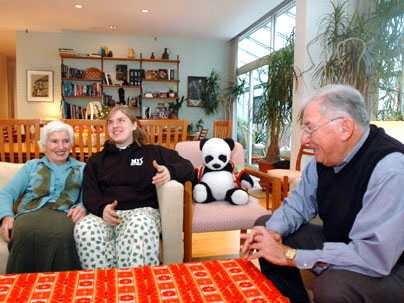For 30 years, Professor Borivoje "Bora" Mikic of mechanical engineering and his wife, Liba, have had a second family of more than 300 students.
Housemasters since 1976, the Mikics' extended family has included first the students at Senior House and then at Next. All told, the Mikics and their two grown daughters have lived with thousands of MIT undergraduates, opening their homes and lives over the years.
For current residents of Next House, a dinner made by Liba Mikic and served in their in-house residence is a treat. So legendary is her food that it was used as an incentive to collect money for charity this fall. Residents of the most generous Next entry won a dinner made by Liba.
It is these kinds of events that bring a house together and make it a home for students who are often living far from their families, said Bora Mikic, who often plays chess with the students.
It was the students who originally drew the Mikics to the job. "They bring energy, a different perspective, and a whole new culture," he said.
At the end of this academic year, the Mikics will leave Next House. Simmons associate housemasters Muriel Medard and John Simmons will move into the position, leaving a vacancy in Simmons. Additionally, senior lecturer in Chinese Julian Wheatley and his wife, Marjorie Nolan-Wheatley, are planning to leave their East Campus housemaster positions after five years.
Senior faculty members interested in applying for either vacancy should e-mail Associate Dean and Director of Student Life Programs Barbara Baker at babaker@mit.edu.
For housemasters, many of whom serve five years or more, leaving a post is bittersweet.
There are 11 undergraduate residences and five graduate residences in the housemaster system. In most cases, housemasters come in a team -- a senior MIT faculty member with his or her spouse or partner. The East Campus, Simmons, Green and Sidney-Pacific dorms also have associate housemasters -- additional faculty members who live there as well.Â
"The housemaster supports and provides leadership to the house team," Baker said. In an undergraduate dorm, that team includes graduate resident tutors (GRTs) -- usually one per floor or entry, a residential life associate, the house manager from the Department of Housing, sometimes an associate housemaster and often the house student leadership.
Housemaster roles and responsibilities vary.
"They are very concerned about student welfare and advocate for student issues and concerns," Baker said. "In addition, housemasters provide support for individual students, including outreach during time of crisis as well as support for student groups, especially the house government."
"Being a housemaster is a way of life and is time consuming," said Professor Munther Dahleh of electrical engineering and computer science. He and his wife, Jinane Abounadi, have been housemasters in MacGregor for more than five years. "Emergencies don't time themselves around your deadlines," said Dahleh, who has found himself in the emergency room with a student all night, then back in class for an 8 a.m. lecture.
Still, Dahleh said the close bonds he and his family have formed with the students and the satisfaction they get from helping make it well worth it. "It becomes a part of your living style. It really is a wonderful experience."
Since they live in apartments within the dorms, the housemasters' lives become intertwined with the lives of all the residents. For the 350 MacGregor residents, having the Dahlehs' three children around is a treat, Dahleh said.
Much of the Dahlehs' job involves working with the house team to offer guidance to the house government on various policies, giving advice to the GRTs on student issues, and planning social and educational activities for the house, such as dinners, study breaks and off-campus outings.
For housemasters in the graduate residences, life is a little different, said Ann Orlando, who has been housemaster of Ashdown House for five years with her husband, Professor Terry Orlando of electrical engineering and computer science. "People here are extremely serious about their studies," she said. And, there are no GRTs.
But, the relationships developed are just as close. "We are rather sad to see some of our residents graduate and leave," she said.
After 30 years, the Mikics have seen a lot of changes, said Bora Mikic. Their two daughters have grown up and moved away. The physical environment for students has improved. And, they have seen growth in the kinds of programs offered to students both in their social and academic lives.
But through it all, the goal has always been the same. "We wanted to offer an environment that allowed them to relax," he said. "They come full of hope and energy and they leave ready to storm the future."
A version of this article appeared in MIT Tech Talk on December 14, 2005 (download PDF).






